FY2011 Science Highlights Archive
Browse NRAO Science Highlights Archives from other years: Recent | FY2012 | Full Archive
Click on each figure to see a larger version.
EVLA Observations of a proto-cluster of molecular gas rich galaxies at z = 4.05
Investigators: C.L. Carilli (NRAO), J. Hodge (MPIA), F. Walter (MPIA), D. Riechers (Caltech), E. Daddi (CEA Saclay), H. Dannerbauer (MPIA), G. Morrison (Univ Hawaii)
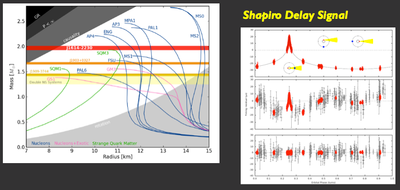 We present observations of the molecular gas in the GN20 proto-cluster of galaxies at z =4.05 using the Expanded Very Large Array (EVLA). This group of galaxies is the ideal laboratory for studying the formation of massive galaxies via luminous, gas-rich starbursts within 1.6 Gyr of the Big Bang. We detect three galaxies in the proto-cluster in CO 2-1 emission, with gas masses (H2) between 1010 and 1011 x (α/0.8) M(sun). The emission from the brightest source, GN20, is resolved with a size ~2", and has a clear north-south velocity gradient, possibly indicating ordered rotation. The gas mass in GN20 is comparable to the stellar mass (1.3 x 1011 x (α/0.8) M(sun) and 2.3 x 1011 M(sun), respectively), and the sum of gas plus stellar mass is comparable to the dynamical mass of the system (~ 3.4 x 1011[sin(i)/sin(45o)]-2 M(sun), within a 5kpc radius. There is also evidence for a tidal tail extending another $2"$ north of the galaxy with a narrow velocity dispersion. GN20 may be a massive, gas rich disk that is gravitationally disturbed, but not completely disrupted. There is one Lyman-break galaxy (BD29079) in the GN20 proto-cluster with an optical spectroscopic redshift within our search volume, and we set a 3 sigma limit to the molecular gas mass of this galaxy of 1.1 x 1010 x (α/0.8) M(sun).
We present observations of the molecular gas in the GN20 proto-cluster of galaxies at z =4.05 using the Expanded Very Large Array (EVLA). This group of galaxies is the ideal laboratory for studying the formation of massive galaxies via luminous, gas-rich starbursts within 1.6 Gyr of the Big Bang. We detect three galaxies in the proto-cluster in CO 2-1 emission, with gas masses (H2) between 1010 and 1011 x (α/0.8) M(sun). The emission from the brightest source, GN20, is resolved with a size ~2", and has a clear north-south velocity gradient, possibly indicating ordered rotation. The gas mass in GN20 is comparable to the stellar mass (1.3 x 1011 x (α/0.8) M(sun) and 2.3 x 1011 M(sun), respectively), and the sum of gas plus stellar mass is comparable to the dynamical mass of the system (~ 3.4 x 1011[sin(i)/sin(45o)]-2 M(sun), within a 5kpc radius. There is also evidence for a tidal tail extending another $2"$ north of the galaxy with a narrow velocity dispersion. GN20 may be a massive, gas rich disk that is gravitationally disturbed, but not completely disrupted. There is one Lyman-break galaxy (BD29079) in the GN20 proto-cluster with an optical spectroscopic redshift within our search volume, and we set a 3 sigma limit to the molecular gas mass of this galaxy of 1.1 x 1010 x (α/0.8) M(sun).
Publication: ApJ Letters EVLA special issue, 2011. arXiv: 1105.2451V1 (29 Aug 2011)
Water Masers in the Andromeda Galaxy: The First Step toward Proper Motion
Investigators: Jeremy Darling (Univ Colorado-Boulder)
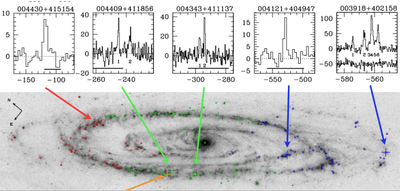 We have detected and confirmed five water maser complexes in the Andromeda Galaxy (M31) using the Green Bank Telescope. These masers will provide the high brightness temperature point sources needed for proper motion studies of M31, enabling measurement of its full three-dimensional velocity vector and its geometric distance via proper rotation. The motion of M31 is the keystone of Local Group dynamics and a gateway to the dark matter profiles of galaxies in general. Our survey for water masers selected 206 luminous compact 24 micron-emitting regions in M31 and was sensitive enough to detect any maser useful for ~10 microarcsecond per year astrometry. The newly discovered masers span the isotropic luminosity range 0.3-1.9 x 10^-3 L(Sun) in single spectral components and are analogous to luminous Galactic masers. The masers are distributed around the molecular ring, including locations close to the major and minor axes, which is nearly ideal for proper motion studies. We find no correlation between 24 micron luminosity and water maser luminosity, suggesting that while water masers arise in star-forming regions, the nonlinear amplification pathways and beamed nature of the water masers means that they are not predictable based on IR luminosity alone. This suggests that there are additional bright masers to be found in M31. We predict that the geometric distance and systemic proper motion of M31 can be measured in 2-3 years with current facilities. A "moving cluster" observation of diverging masers as M31 approaches the Galaxy may be possible in the long term.
We have detected and confirmed five water maser complexes in the Andromeda Galaxy (M31) using the Green Bank Telescope. These masers will provide the high brightness temperature point sources needed for proper motion studies of M31, enabling measurement of its full three-dimensional velocity vector and its geometric distance via proper rotation. The motion of M31 is the keystone of Local Group dynamics and a gateway to the dark matter profiles of galaxies in general. Our survey for water masers selected 206 luminous compact 24 micron-emitting regions in M31 and was sensitive enough to detect any maser useful for ~10 microarcsecond per year astrometry. The newly discovered masers span the isotropic luminosity range 0.3-1.9 x 10^-3 L(Sun) in single spectral components and are analogous to luminous Galactic masers. The masers are distributed around the molecular ring, including locations close to the major and minor axes, which is nearly ideal for proper motion studies. We find no correlation between 24 micron luminosity and water maser luminosity, suggesting that while water masers arise in star-forming regions, the nonlinear amplification pathways and beamed nature of the water masers means that they are not predictable based on IR luminosity alone. This suggests that there are additional bright masers to be found in M31. We predict that the geometric distance and systemic proper motion of M31 can be measured in 2-3 years with current facilities. A "moving cluster" observation of diverging masers as M31 approaches the Galaxy may be possible in the long term.
Publication: Astrophysical Journal Letters. arXiv: 1103.4788 (6 Apr 2011)
Modeling the Magnetic Field in the Galactic Disk using New Rotation Measure Observations from the Very Large Array
Investigators: Cameron Van Eck (1), Jo-Anne Brown (1), Jeroen Stil (1), Kyle Rae (1), Sui Ann Mao (2,3), Bryan Gaensler (4), Anvar Shukurov (5), Russ Taylor (1), Marijke Haverkorn (6,7), Phil Kronberg (8,9), Naomi McClure-Griffiths (3)
(1) Univ Calgary, (2) Harvard-Smithsonian Center for Astrophysics, (3) ATNF, CSIRO Astronomy and Space Science, (4) Sydney Institute for Astronomy, (5) Univ Newcastle, (6) ASTRON, (7) Leiden Univ, (8) Univ Toronto, (9) Los Alamos National Laboratory.
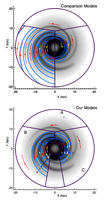 We have determined 194 Faraday rotation measures (RMs) of polarized extragalactic radio sources using new, multi-channel polarization observations at frequencies around 1.4 GHz from the Very Large Array (VLA) in the Galactic plane at 17o ≤ l≤ 63o and 205o ≤ l ≤ 253o. This catalog fills in gaps in the RM coverage of the Galactic plane between the Canadian Galactic Plane Survey and Southern Galactic Plane Survey. Using this catalog we have tested the validity of recently-proposed axisymmetric and bisymmetric models of the large-scale (or regular) Galactic magnetic field, and found that of the existing models we tested, an axisymmetric spiral model with reversals occurring in rings (as opposed to along spiral arms) best matched our observations. Building on this, we have performed our own modeling, using RMs from both extragalactic sources and pulsars. By developing independent models for the magnetic field in the outer and inner Galaxy, we conclude that in the inner Galaxy, the magnetic field closely follows the spiral arms, while in the outer Galaxy, the field is consistent with being purely azimuthal.Furthermore, the models contain no reversals in the outer Galaxy, and together seem to suggest the existence of a single reversed region that spirals out from the Galactic center.
We have determined 194 Faraday rotation measures (RMs) of polarized extragalactic radio sources using new, multi-channel polarization observations at frequencies around 1.4 GHz from the Very Large Array (VLA) in the Galactic plane at 17o ≤ l≤ 63o and 205o ≤ l ≤ 253o. This catalog fills in gaps in the RM coverage of the Galactic plane between the Canadian Galactic Plane Survey and Southern Galactic Plane Survey. Using this catalog we have tested the validity of recently-proposed axisymmetric and bisymmetric models of the large-scale (or regular) Galactic magnetic field, and found that of the existing models we tested, an axisymmetric spiral model with reversals occurring in rings (as opposed to along spiral arms) best matched our observations. Building on this, we have performed our own modeling, using RMs from both extragalactic sources and pulsars. By developing independent models for the magnetic field in the outer and inner Galaxy, we conclude that in the inner Galaxy, the magnetic field closely follows the spiral arms, while in the outer Galaxy, the field is consistent with being purely azimuthal.Furthermore, the models contain no reversals in the outer Galaxy, and together seem to suggest the existence of a single reversed region that spirals out from the Galactic center.
Publication: Astrophysical Journal, 2011, 728, 97. arXiv: 1012.2938V1 (25 Jan 2011)
VLBA Astrometric Observations of the Cassini Spacecraft at Saturn
Investigators: Dayton L. Jones (JPL); Ed Fomalong, Vivek, Dhawan, Jon Romney (NRAO); William M Folkner, Gabor Lanyi, James Border and Bob Jacobson (JPL).
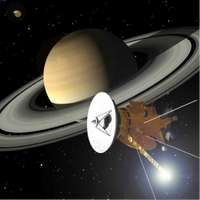 The planetary ephemeris is an essential tool for interplanetary spacecraft navigation, studies of solar system dynamics (including, for example, barycenter corrections for pulsar timing ephemeredes), the prediction of occultations, and tests of general relativity. We are carrying out a series of astrometric VLBI observations of the Cassini spacecraft currently in orbit around Saturn, using the Very Long Baseline Array (VLBA). These observations provide positions for the center of mass of Saturn in the International Celestial Reference Frame (ICRF) with accuracies ~0.3 milli-arcsecond (1.5 nrad), or about 2 km at the average distance of Saturn. This paper reports results from eight observing epochs between 2006 October and 2009 April. These data are combined with two VLBA observations by other investigators in 2004 and a Cassini-based gravitational deflection measurement by Fomalont et al. in 2009 to constrain a new ephemeris (DE 422). The DE 422 post-fit residuals for Saturn with respect to the VLBA data are generally 0.2 mas, but additional observations are needed to improve the positions of all of our phase reference sources to this level. Over time we expect to be able to improve the accuracy of all three coordinates in the Saturn ephemeris (latitude, longitude, and range) by a factor of at least three. This will represent a significant improvement not just in the Saturn ephemeris but also in the link between the inner and outer solar system ephemeredes and in the link to the inertial ICRF.
The planetary ephemeris is an essential tool for interplanetary spacecraft navigation, studies of solar system dynamics (including, for example, barycenter corrections for pulsar timing ephemeredes), the prediction of occultations, and tests of general relativity. We are carrying out a series of astrometric VLBI observations of the Cassini spacecraft currently in orbit around Saturn, using the Very Long Baseline Array (VLBA). These observations provide positions for the center of mass of Saturn in the International Celestial Reference Frame (ICRF) with accuracies ~0.3 milli-arcsecond (1.5 nrad), or about 2 km at the average distance of Saturn. This paper reports results from eight observing epochs between 2006 October and 2009 April. These data are combined with two VLBA observations by other investigators in 2004 and a Cassini-based gravitational deflection measurement by Fomalont et al. in 2009 to constrain a new ephemeris (DE 422). The DE 422 post-fit residuals for Saturn with respect to the VLBA data are generally 0.2 mas, but additional observations are needed to improve the positions of all of our phase reference sources to this level. Over time we expect to be able to improve the accuracy of all three coordinates in the Saturn ephemeris (latitude, longitude, and range) by a factor of at least three. This will represent a significant improvement not just in the Saturn ephemeris but also in the link between the inner and outer solar system ephemeredes and in the link to the inertial ICRF.
Publication: Astronomical Journal, 141, 29. arXiv: 1012.0264 (29 Dec 2010)
The Massive Pulsar PSR J1614-2230: Linking Quantum Chromodynamics, Gamma-ray Bursts, and Gravitational Wave Astronomy
Investigators: Feryal Ozel (1), Dimitrios Psaltis (1), Scott Ransom (2), Paul Demorest (2), Mark Alford (3)
(1) Univ Arizona, (2) NRAO, (3) Washington Univ.
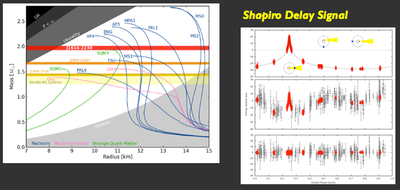 The recent measurement of the Shapiro delay in the radio pulsar PSR J1614-2230 yielded a mass of 1.97 +/- 0.04 M_sun, making it the most massive pulsar known to date. Its mass is high enough that, even without an accompanying measurement of the stellar radius, it has a strong impact on our understanding of nuclear matter, gamma-ray bursts, and the generation of gravitational waves from coalescing neutron stars. This single high mass value indicates that a transition to quark matter in neutron-star cores can occur at densities comparable to the nuclear saturation density only if the quarks are strongly interacting and are color superconducting. We further show that a high maximum neutron-star mass is required if short duration gamma-ray bursts are powered by coalescing neutron stars and, therefore, this mechanism becomes viable in the light of the recent measurement. Finally, we argue that the low-frequency (<= 500 Hz) gravitational waves emitted during the final stages of neutron-star coalescence encode the properties of the equation of state because neutron stars consistent with this measurement cannot be centrally condensed. This will facilitate the measurement of the neutron star equation of state with Advanced LIGO/Virgo.
The recent measurement of the Shapiro delay in the radio pulsar PSR J1614-2230 yielded a mass of 1.97 +/- 0.04 M_sun, making it the most massive pulsar known to date. Its mass is high enough that, even without an accompanying measurement of the stellar radius, it has a strong impact on our understanding of nuclear matter, gamma-ray bursts, and the generation of gravitational waves from coalescing neutron stars. This single high mass value indicates that a transition to quark matter in neutron-star cores can occur at densities comparable to the nuclear saturation density only if the quarks are strongly interacting and are color superconducting. We further show that a high maximum neutron-star mass is required if short duration gamma-ray bursts are powered by coalescing neutron stars and, therefore, this mechanism becomes viable in the light of the recent measurement. Finally, we argue that the low-frequency (<= 500 Hz) gravitational waves emitted during the final stages of neutron-star coalescence encode the properties of the equation of state because neutron stars consistent with this measurement cannot be centrally condensed. This will facilitate the measurement of the neutron star equation of state with Advanced LIGO/Virgo.
Publication: Accepted for ApJ Letters. arXiv: 1010.5790V1 (10 Nov 2010)
An Intensity Map of Hydrogen 21-cm Emission at Redshift z ~ 0.8
Investigators: Tzu-Ching Chang (Academia Sinica, CITA-Toronto), Ue-Li Pen (CITA-Toronto), Kevin Bandura (Carnegie Mellon Univ), Jeffrey B. Peterson (Carnegie Mellon Univ)
 Observations of 21-cm radio emission by neutral hydrogen at redshifts z ≈ 0.5 to ~2.5 are expected to provide a sensitive probe of cosmic dark energy. This is particularly true around the onset of acceleration at z ≈ 1, where traditional optical cosmology becomes very difficult because of the infrared opacity of the atmosphere. Hitherto, 21-cm emission has been detected only to z = 0.24. More distant galaxies generally are too faint for individual detections but it is possible to measure the aggregate emission from many unresolved galaxies in the ‘cosmic web’. Here we report a three-dimensional 21-cm intensity field at z = 0.53 to 1.12. We then co-add neutral-hydrogen (H I) emission from the volumes surrounding about 10,000 galaxies (from the DEEP2 optical galaxy redshift survey). We detect the aggregate 21-cm glow at a significance of ~4σ.
Observations of 21-cm radio emission by neutral hydrogen at redshifts z ≈ 0.5 to ~2.5 are expected to provide a sensitive probe of cosmic dark energy. This is particularly true around the onset of acceleration at z ≈ 1, where traditional optical cosmology becomes very difficult because of the infrared opacity of the atmosphere. Hitherto, 21-cm emission has been detected only to z = 0.24. More distant galaxies generally are too faint for individual detections but it is possible to measure the aggregate emission from many unresolved galaxies in the ‘cosmic web’. Here we report a three-dimensional 21-cm intensity field at z = 0.53 to 1.12. We then co-add neutral-hydrogen (H I) emission from the volumes surrounding about 10,000 galaxies (from the DEEP2 optical galaxy redshift survey). We detect the aggregate 21-cm glow at a significance of ~4σ.
Publication: Nature, 466, 463 (22 July 2010).


